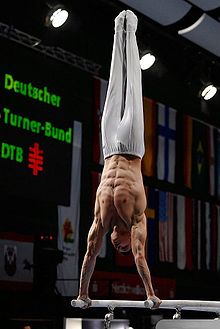Parallel bars

Parallel bars is an apparatus used by male gymnasts in artistic gymnastics. Gymnasts may optionally wear grips when performing a routine on the parallel bars, although this is uncommon.
The apparatus
The apparatus consists of two parallel bars that are held parallel to, and elevated above, the floor by a metal supporting framework. The bars are composed of wood or other material, with an outer coating of wood.[1] The vertical members of the supporting framework are adjustable so the height of the bars above the floor and distance between the bars can be set optimally for each gymnast.[2]
Dimensions
- Bar length: 350 centimetres (11.5 ft) ± 1 centimetre (0.39 in)[2]
- Bar rounded profile: 5 centimetres (2.0 in) ± 1 millimetre (0.039 in) vertical by 4 centimetres (1.6 in) ± 1 millimetre (0.039 in) horizontal [2]
- Bar width: 4 centimetres (1.6 in) ± 1 millimetre (0.039 in)[2]
- Height of bar from floor: 200 centimetres (6.6 ft) ± 1 centimetre (0.39 in)[2]
- Distance between bars: 42 centimetres (17 in) - 52 centimetres (20 in) (adjustable)[2]
Routines
A routine performed on the parallel bars must include various elements that depend on the gymnast's competitive level. A typical performance will involve swinging skills in a support position (on the hands), a hanging position, and an upper arm position[clarification needed]. Also, parallel bar routines often feature a strength or static hold skill [clarification needed]. Each routine ends with a dismount from either the ends of the bars or the side of the apparatus.
International level routines
A parallel bar routine should contain at least one element from all element groups:[3]
- I. Elements in support or through support
- II. Elements starting in upper arm position
- III. Long swings in hang, face on 1 or 2 rails
- IV. Underswings
- V. Dismounts
Scoring and Rules
Deductions are taken for form and exactness of elements performed. There are specific deductions for adjusting hand position in handstand and not controlling swing elements;[4] swing type elements should momentarily show handstand.[3]
References
- ^ "Apparatus Norms" (PDF). FIG. p. II/27. Retrieved 2009-10-20.
- ^ a b c d e f "Apparatus Norms" (PDF). FIG. p. II/28. Retrieved 2009-10-20.
- ^ a b "MAG Code of Points 2009-2012" (PDF). FIG. p. 100. Retrieved 2009-10-20.
- ^ "MAG Code of Points 2009-2012" (PDF). FIG. p. 101. Retrieved 2009-10-20.
See also
